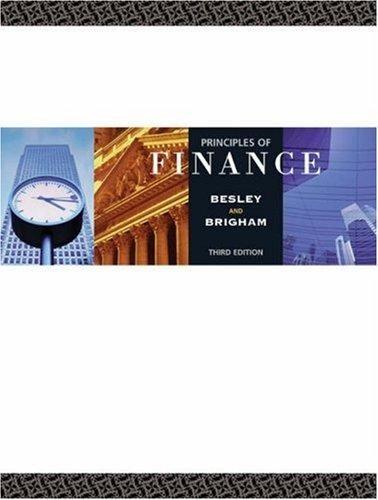Question
1. The reconciliation from GAAP net income to FFO does not include? (1)Adding back depreciation of real estate assets (2) Adding back amortization of capitalized
1. The reconciliation from GAAP net income to FFO does not include?
(1)Adding back depreciation of real estate assets
(2) Adding back amortization of capitalized items
(3) Deducting amortization of debt
(4) Eliminating gains or losses from the sale of property
2. According to Green Street, AFFO is a superior metric to FFO in measuring equity REIT cash flow. Green Street Advisors identifies the major adjustment to FFO as the?
(1) Deduction from FFO of recurring capital expenditures required to keep a property competitive
(2) Deduction from FFO of gains or losses from discontinued operations.
(3) Deduction from FFO of the book value of TRSs.
(4) Marking to market the companys outstanding preferred stock
3. Which one of these is a requirement for a US REIT to maintain its tax-exempt status?
(1) The company must have 100 or more shareholders.
(2) The companys shares are traded on a major exchange.
(3) The company must distribute, as dividends, at least 90%, but not more than 100%, of the companys FFO to shareholders.
(4) The companys annual report must calculate the reconciliation of FFO in accordance with the NAREIT definition of FFO.
4. Many of the REITs going public in the late 1960s and early 1970s were commercial bank sponsored mortgage REITs engaged in the business of lending on construction and development of commercial real estate. Most of these C&D REITs failed because of?
(1) The Tax Reform Act of 1986
(2) The severe and sudden inflation caused by OPEC embargo and the subsequent recession lasting most of the decade of the 1970s.
(3) The bursting of the Japanese bubble and the consequent Lost Decade
(4) The effects of the Basel Accords
5. AFFO (CAD/FAD/MFFO or whatever) is intended to most approximate cash flow. Therefore, differences between FFO and AFFO will most likely to be the greatest in equity REITs that own and operate
(1) Timberland
(2) Office buildings
(3) Self-storage facilities
(4) Net leased properties
6. If an equity REIT pays a dividend in excess of 100% of its taxable income, that portion of the dividend will be deemed to be a return of capital to the shareholders, and, as such?
(1) Will be tax exempt
(2) Will be tax deferred by reducing the tax basis of the shareholders
(3) Will be taxed as a capital gain
(4) Will be taxed as ordinary income
7. Non-exchange traded REITs appeal to a specific class of investors:?
(1) Individual investors
(2) REIT mutual funds
(3) Corporate pension funds
(4) Hedge funds
8. The primary attraction of non-exchange traded equity REITs is?
(!) Generally management that is considered superior to listed REITs
(2) More detailed coverage by the analyst community
(3) Greater total return (dividend + share appreciation) than listed companies
(4) None of the above
9. Which of the following class of investors owns the largest percentage of US publicly traded REIT shares?
(1) Hedge funds
(2) US domestic mutual funds
(3) Individual retail investors
(4) Sovereign wealth funds
10. Private equity sources are inclined to be investors in commercial real estate on a direct, rather than indirect, basis. What is considered to be indirect investing?
(1) Investing in managed funds that purchase commercial properties
(2) Investing in publicly traded REIT shares
(3) Acquiring public real estate companies
(4) Joint venturing with public real estate companies.
11. An IPO of an UPREIT?
(1) Defers capital gains tax for property contributors the with respect to the properties contributed to the Operating Partnership.
(2) Creates a non-marketable security that represents the property contributors residual interest in the entity that owns the REITs properties.
(3) Does both (a) and (b).
(4) Does neither (a) nor (b).
12. Prior to the credit crisis beginning in 2007, equity REITs had difficulty competing with private buyers in purchasing investment grade properties because?
(1) Of the easy availability of debt capital for private buyers
(2) Of the market constraint put on public REITs to maintain low leverage levels
(3) The prices at which these properties traded would likely be initially dilutive to the REIT and could impact the REITs ability to maintain dividend levels
(4) All of the above
Step by Step Solution
There are 3 Steps involved in it
Step: 1

Get Instant Access to Expert-Tailored Solutions
See step-by-step solutions with expert insights and AI powered tools for academic success
Step: 2

Step: 3

Ace Your Homework with AI
Get the answers you need in no time with our AI-driven, step-by-step assistance
Get Started


